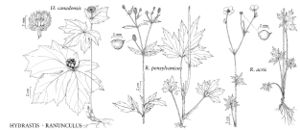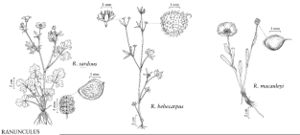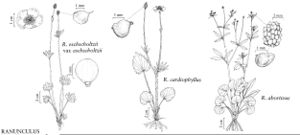Ranunculus
Sp. Pl. 1: 548. 175.
Gen. Pl. ed. 5, 243. 1754.
Herbs, annual or perennial, from tuberous roots, caudices, rhizomes, stolons, or bulbous stem-bases. Leaves basal, cauline, or both, simple, variously lobed or parted, or compound, all petiolate or distal leaves sessile; cauline leaves alternate (rarely a distal pair opposite in Ranunculus sect. Flammula). Leaf-blade reniform to linear, margins entire, crenate, or toothed. Inflorescences terminal or axillary, 2-50-flowered cymes to 25 cm or solitary flowers; bracts present or absent, small or large and leaflike, not forming involucre. Flowers bisexual, radially symmetric; sepals sometimes persistent in fruit, 3-5 (-6), green or sometimes purple, yellow, or white, plane (base saccate in R. ficaria), oblong to elliptic, ovate, or lanceolate, 1-15 mm; petals 0-22 (-150), distinct, yellow, rarely white, red, or green, plane, linear to orbiculate, 1-26 mm; nectary present, usually covered by scale; stamens (5-) 10-many; filaments filiform; staminodes absent between stamens and pistils; pistils 4-250, simple; ovule 1 per ovary; style present or absent. Fruits achenes, rarely utricles, aggregate, sessile, discoid, lenticular, globose, obovoid, or cylindric, sides sometimes veined; beak present or absent, terminal, straight or curved, 0-4.5 mm. x = 7, 8.
Distribution
Worldwide except lowland tropics
Discussion
Species about 300 (76 in the flora).
Most Ranunculus species are poisonous to stock; when abundant, they may be troublesome to ranchers. A few species with acrid juice were formerly used as vesicatories. The genus is badly in need of biosystematic work. Apomixis and interspecific hybridization occur in several Old World groups of buttercups; some of the taxonomic complexity of the New World species probably results from these processes.
Considerable disagreement exists among authors on the proper generic and infrageneric classification of Ranunculus. Most of the subgenera accepted here have been treated as separate genera at one time or another. All recent studies have been based on local or continental floras, however, and classifications proposed for one region may not work for the plants of other regions. Like most North American workers, I have followed the generic and infrageneric classification of L. D. Benson (1948), who gave by far the most thorough and best documented study of the problem. The genus and its subdivisions should be studied on a worldwide basis.
Selected References
None.
Lower Taxa
Key
| 1 | All leaves simple and unlobed. | > 2 |
| 1 | Some or all leaves simple and lobed, or compound. | > 9 |
| 2 | Cauline leaves absent or scalelike; sepals deciduous or persistent. | > 3 |
| 2 | Cauline leaves present, well developed; sepals deciduous. | > 5 |
| 3 | Petals 5; achene beak 0.1-0.2 mm; plants stoloniferous, without caudices. | Ranunculus subg. Cyrtorhyncha sect. Halodes (Ranunculus cymbalaria) |
| 3 | Petals 8-18; achene beak 0.8-1.4 mm; plants not stoloniferous, stems erect from short caudices. | > 4 |
| 4 | Leaf blades undivided, margins entire or serrulate; sepals persistent in fruit; petals 7-12 mm. | Ranunculus subg. Oxygraphis (Ranunculus kamtschaticus) |
| 4 | Leaf blades shallowly lobed, margins crenate; sepals deciduous; petals 2-4 mm | Ranunculus subg. Cyrtorhyncha sect. Pseudaphanostemma (Ranunculus hystriculus) |
| 5 | Tuberous roots present; flowers yellow; sepals 3. | Ranunculus subg. Ficaria (Ranunculus ficaria) |
| 5 | Tuberous roots absent (roots thickened proximally in some 5-sepaled species of sect. Flammula); flowers yellow, white, or pink. | > 6 |
| 6 | Achenes 4.2-5.2 mm, achene body prolonged beyond seed as corky distal appendage; sepals 3, 6-10 mm; petals white to pink. | Ranunculus subg. Pallasiantha (Ranunculus pallasii) |
| 6 | Achenes 0.8-2.8 mm, achene body not prolonged beyond seed; sepals (3-)4-5, 1.5-12 mm; petals yellow. | > 7 |
| 7 | Sepals covered with dense brown pubescence; distal leaves and bracts apically 3-crenate or shallowly 3-lobed, otherwise undivided. | Ranunculus subg. Ranunculus sect. Epirotes (Ranunculus macauleyi) |
| 7 | Sepals glabrous or with colorless hairs; distal leaves simple and undivided. | > 8 |
| 8 | Achene wall papery, longitudinally ribbed; leaf apex broadly rounded to truncate, margins crenate. | Ranunculus subg. Cyrtorhyncha sect. Halodes (Ranunculus cymbalaria) |
| 8 | Achene wall thick, not ornamented, smooth (sometimes pubescent); leaf apex acuminate to rounded-obtuse, margins entire or finely toothed. | Ranunculus sect. Flammula |
| 9 | Leafy stems creeping and rooting at nodes or floating in water, then rootless. | > 10 |
| 9 | Leafy stems erect or if decumbent rooting only at base, never floating. | > 14 |
| 10 | Leaves 3-foliolate. | Ranunculus sect. Ranunculus |
| 10 | Leaves simple, lobed to filiform-dissected or occasionally undivided. | > 11 |
| 11 | Achene body prolonged beyond seed as corky distal appendage; sepals 3, petals 5-11. | > 12 |
| 11 | Achene body not prolonged beyond seed; either sepals 5 or sepals 3-4 and petals also 3-4. | > 13 |
| 12 | Leaf blade as wide as long, ternately divided to base. | Ranunculus subg. Coptidium (Ranunculus lapponicus) |
| 12 | Leaf blade much longer than wide, unlobed or lobed. | Ranunculus subg. Pallasiantha (Ranunculus pallasii) |
| 13 | Petals white or white with yellow claws; achenes with strong coarse wrinkles. | Ranunculus subg. Batrachium |
| 13 | Petals yellow; achenes smooth (faintly wrinkled in R. sceleratus var. sceleratus). | Ranunculus sect. Hecatonia |
| 14 | Petals pure red, or white when immature; fruits winged achenes or utricles. | Ranunculus subg. Crymodes |
| 14 | Petals yellow, rarely also with some red pigmentation abaxially, or greenish yellow; fruits achenes, rarely winged. | > 15 |
| 15 | Cauline leaves absent or scalelike, tuberous roots absent; leaves sometimes deeply parted or dissected, never compound. | > 16 |
| 15 | Cauline leaves present, simple, lobed or dissected, or compound (rarely reduced to scales in R. fascicularis with tuberous roots and 3-5-foliolate leaves). | > 18 |
| 16 | Plants villous; sepals 3-6 × 1-2 mm, persistent in fruit; fruit wall firm, smooth, beak much longer than achene body. | Ranunculus subg. Ceratocephala (Ranunculus testiculatus) |
| 16 | Plants glabrous; sepals 6-13 × 3-7 mm, deciduous in fruit; fruit wall thin, veined, beak much shorter than achene body. | > 17 |
| 17 | Leaves shallowly 5-7-lobed; petals inconspicuous, 2-4 mm. | Ranunculus subg. Cyrtorhyncha sect. Pseudaphanostemma (Ranunculus hystriculus) |
| 17 | Leaves 3-5-parted; petals showy, 8-12 mm. | Ranunculus subg. Cyrtorhyncha Sect. Arcteranthis (Ranunculus cooleyae) |
| 18 | Style absent, stigma sessile; achene margins thick and corky; emergent aquatic, sometimes also found on very wet soil. | Ranunculus subg. Ranunculus Sect. Hecatonia (Ranunculus sceleratus) |
| 18 | Style present; achene margins not corky; in various habitats but rarely aquatic. | > 19 |
| 19 | Achene wall thin, longitudinally striate; scale of nectary reduced to low ridge, not covering nectary. | Ranunculus subg. Cyrtorhyncha Sect. Cyrtorhyncha (Ranunculus ranunculinus) |
| 19 | Achene wall thick, smooth, papillose, or spiny; scale of nectary well-developed flap or pocket completely covering nectary. | > 20 |
| 20 | Achenes thick-lenticular or asymmetrically thick-lenticular to compressed-globose, 1.2-2 times as wide as thick; nectary scale joined with petal on 3 sides, forming pocket enclosing nectary (sometimes with apex free, forming flap shorter than pocket); basal leaves various, unlobed to deeply divided, margins entire to crenate but never at all serrate. | Ranunculus sect. Epirotes |
| 20 | Achenes strongly flattened, at least 3-15 times as wide as thick; nectary scale free from petal for at least 1/2 its length, thus forming free scale over nectary (scale sometimes free for less than 1/2 its length in R. recurvatus, with serrate to crenate-serrate leaf margins); basal leaves always deeply lobed or compound (except sometimes in R. marginatus and R. orthorhynchus), margins various. | > 21 |
| 21 | Achenes papillose or spiny (sometimes smooth in R. sardous); flowers small, petals 1-6 mm, scarcely longer than sepals, sometimes absent (larger and much longer than sepals in R. sardous). | Ranunculus sect. Echinella |
| 21 | Achenes smooth, glabrous or pubescent; flowers small to large, petals always present, 2-22 mm. | Ranunculus sect. Ranunculus |


